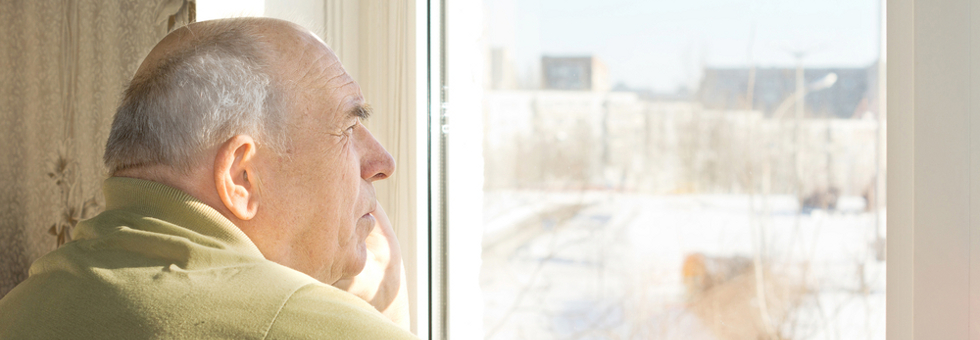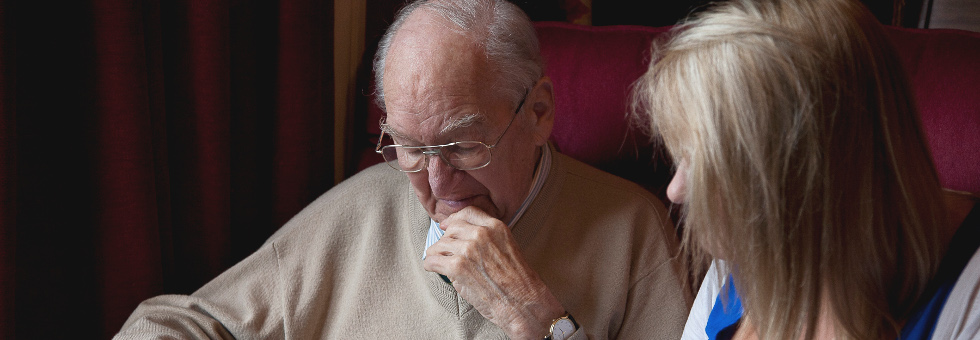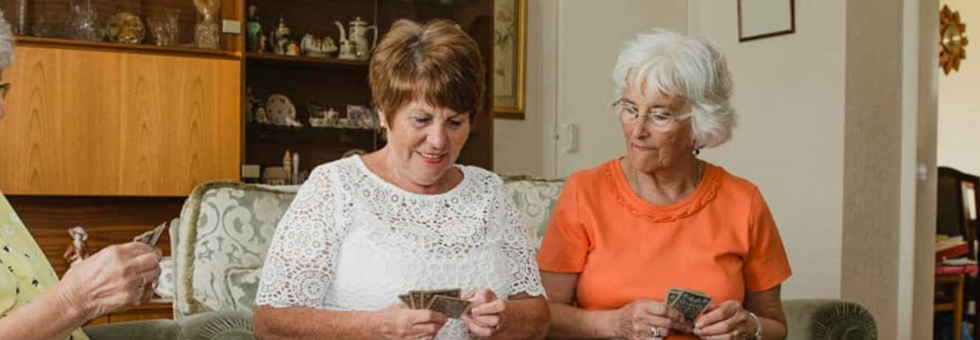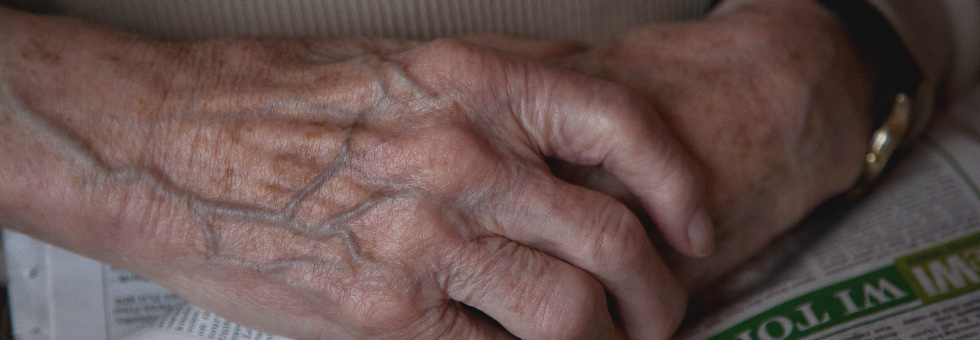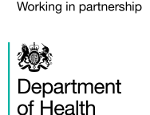Contents
This stage of the case study provides the following information.
- The Personal History sets out what is happening for Don and Madge.
- Values and Ethics – Relating to: Dignity and human rights; Care ethics; Need and risk
- Law and policy – Relating to: What to do after a death; Assessment and care planning; Personal budgets, direct payments and financial assessment
- Knowledge, Evidence and Good Practice – Relating to: Bereavement; Concurrent losses; Bereavement support
- Skills – Relating to: Crisis intervention; Exercising empathy and insight; Communication
- Activities – Relating to: Personal budgets and/or direct payments; Learning from assessment; Improving understanding; Meeting standards
- Additional resources – Relating to: Bereavement; Finance; Depression; Communication; BME adults; Reducing social isolation
Personal History
One morning Madge went to work in the greenhouse where hours later Don found her unconscious on the floor. He called an ambulance and Madge was confirmed dead on arrival at the local hospital. Karen took Don to the hospital to see Madge’s body and he telephoned Charlie, who came straight away.
Madge’s sudden death from a heart attack left Don feeling numb and bewildered. Neighbours were kind, the vicar and other church members visited regularly. Charlie helped to arrange Madge’s funeral – the couple had planned and paid for their funerals in advance to avoid being a nuisance to anyone.
Although Don tried to get dressed each morning, as he knew Madge would expect him to make an effort, he would often find time had passed and he was still in his pyjamas. He ate sporadically and drank wine to help him sleep. Charlie came to try and sort out the practical things that needed doing after Madge’s death. He invited Don to stay with him, but Don flatly refused.
On the days that Karen came, she encouraged him to dress and to eat something. She worried that he was forgetting (or not bothering) to take his medication. Neighbours called with food and to offer support, but were afraid of intruding. Church friends came and tried to encourage Don to go to church but he refused. He often did not answer the door to callers.
Within two weeks of the funeral, Don was clearly ill. Sometimes he seemed confused and uninterested in what was going on around him. One morning Karen found him on the bedroom floor. Don had tripped on a rug and become wedged between the bed and the bedside cabinet. An ambulance was called but, as he was not injured and Karen was present, he was not taken to hospital. Instead his GP was contacted.
The GP visited and said that she would refer Don to a social worker, as it seemed that Don was not coping well on his own. Although Don was suspicious of social workers, he did not have the energy to object. The GP also arranged for a community nurse to visit and gave Don a leaflet about the local bereavement service – which stayed unread beside his bed. In the meantime, Karen increased her visits on an informal, unpaid basis.
Two weeks later a social worker, Jodie Brown, visited Don and, following an assessment, arranged additional care. Don now had help with washing and dressing in the morning and to help him with his medication. Don’s finances were assessed and he paid a contribution for the additional help. Jodie was aware that there were complex issues at play in his situation but Don insisted that he only needed practical help and was reluctant to discuss anything further.
Don found the new arrangements difficult to cope with. He was often confused about who was coming and when and what they were supposed to do. He felt that the carers were often late, rushed and keen to leave. He was embarrassed having women he did not know help him wash and dress and he tried to get ready before they arrived. He was not sure who was paying them and muddled up the cost of the new care with his private arrangement for Karen.
Don felt engulfed by grief. He feared that if people knew how bad things were, he would be sent to a care home and would lose Sprocket, his dog, who was very precious to him, along with the home he had shared with Madge. At times he thought it would be better to put an end to his life so that he could be with Madge.
Matters came to a head when Don was found collapsed by care workers and taken to hospital.
Values and Ethics
Don’s situation raises some critical questions related to social work values and professional ethics. As an older man with health problems and high support needs Don may be seen as someone whose life does not matter much. He is living in a time and place where there are frequent references to the cost of an ageing society and to older people as ‘bed blockers’ or ‘burdens’.
The inherent worth and dignity of every individual is a core social work value, yet social workers often feel this value is undermined by organisational pressures including high caseloads and a focus on rationing care. Managing this tension calls for careful and sensitive professional judgement to ensure that needs and agreed outcomes are met and preventive strategies are in place. In Don’s case, for example, skilful and timely crisis intervention involving assessment, support planning, inter-professional working and perhaps onward referral for longer-term therapeutic intervention would be a way forward that is consistent with social work values.
To work effectively and in a way that upholds the dignity and human rights of older people, social workers need the support of their employer. The Local Government Association (LGA) Standards for Employers set out what social workers can expect from their organisation to support and sustain excellent social work practice. These include, for example, that social workers should have safe and manageable workloads, regular and appropriate social work supervision and opportunities for Continuing Professional Development (CPD).
Care ethics
The active and independent older person has become the model for ageing, even though most of us will become dependent on others for help and support in old age (Lloyd et al 2014). An alternative way of looking at Don’s situation is provided by the care ethics approach, which calls for a re-evaluation of care and interdependence as fundamental to human well-being, for all groups throughout the lifespan. Care ethics provides a critical perspective on care as conceived and practised at different levels, including the political dimension of collective responsibility, the institutional context in which care work is performed and power relationships in the giving and receiving of care (Ward and Barnes, 2015). These levels are interrelated and shape the way that care is regarded. With independence and self-reliance a dominant value within welfare services and the need for care seen as a sign of failure or victimhood (Townsend et al., 2006), Don’s concerns about accepting care are understandable.
The ideals of self-reliance and independence underpin an assumption that service users will be able to navigate the complex system of care and support established through local markets. This means that social care, instead of being a help in times of need may further disadvantage those who, like Don, are least able to engage with the system.
It should be emphasised that this is not to argue for an approach which denies people the chance to exercise choice and control. The point is that there is more to social work and social care than simply promoting choice and control and that care should be understood as a core value and a common human need. As Ward and Barnes argue- the necessity is to ‘include care within practice rather than abandoning it in favour of choice’ (2015:15).
I’m sorry that it’s so long after Madge’s death that a social worker appears. Yes Charlie and Karen have supported and other people too, but that often falls off quite quickly. There is still a gap. The social worker, the skill would be not to impose anything because it’s so important for him to trust her because everything she will achieve later will be on that trust. He has to trust her. The Nurse offered a bereavement service which is a logical thing to do but what appears to be a private man wouldn’t want this imposed and the social worker could be the person who helps him gradually accept more help. (Mike)
Need and Risk
Situations where a person’s best interests (in the broadest sense) take precedence over their stated wishes are relatively frequent in social work. So what might a care ethics approach bring to practice with Don?
A social worker using a care ethics approach would prioritise Don’s need for human contact with people that he can trust in developing a support plan. For example, it would be important to ensure that any carers working with Don understand his need for human contact and potentially a confidant. The plan might also include developing contacts that have nothing to do with service provision but may re-build Don’s social network. His fear about being sent to a care home needs to be allayed and his ability to accept help encouraged by showing him that his situation is understood and that he is not seen as a burden. Attention to his physical health may lead to improvements in his mental health but in any case must have high priority.
If Don’s thoughts about suicide continue, he may, like many other widowers, die within months of his wife. Evidence suggests that a sense of loneliness continues in widowed people, despite the presence of social support, but social isolation is also a causal factor in depression (Cacioppo et al., 2006). Tackling Don’s social isolation might therefore be the way to manage the ethical dilemmas posed by his apparent wish to die. \
References
- Cacioppo J.T., Hughes M.E. and Waite L.J. (2006) Loneliness as a specific risk factor for depressive symptoms: Cross-sectional and longitudinal analyses, Psychology and Aging, 21(1):140-151
- Lloyd, L., Tanner, D., Milne, A., Ray, M., Richards, S., Sullivan, M.P., Beech, C. and Phillips, J. (2014) Look after yourself: active ageing, individual responsibility and the decline of social work with older people in the UK’. European Journal of Social Work, 17(3):322-335.
- Townsend, J., Godfrey, M. and Denby, T. (2006) Heroines, villains and victims: older people’s perceptions of others, Ageing and Society, 26/6:883-900.
- Ward, E. and Barnes, M. (2015) Transforming practice with older people through an ethic of care British Journal of Social Work. pp. 1-17. ISSN 0045-3102).
Law and Policy
(a) What to do after a death
Dealing with legal responsibilities after a death is stressful and demanding for bereaved people and Don is likely to need help with these, particularly after the shock of Madge’s sudden death. The Government online service has a lot of useful information about registering a death, and what to do after someone dies, at: .
There are three things that should be done within the days immediately after any death:
- Get a medical certificate from a GP or hospital doctor. Don will need this to register the death.
- Register the deathwithin 5 days (8 days in Scotland). Don will then get the documents needed for the funeral.
- Arrange the funeral.
Other responsibilities are less urgent, although the Benefits Agency must be informed as soon as possible because Madge was receiving the State Retirement Pension. Information on reporting the death of someone on benefits can be found at the Bereavement Service or by contacting The Bereavement Service using a dedicated freephone number – 0800 085 2463. The Bereavement Service will inform each office that paid benefit to the deceased and check the bereaved person’s eligibility to claim benefits, such as Bereavement Benefits and/or a Social Fund Funeral payment. Don might be eligible for benefits depending on the size of his occupational pension.
Alternatively, the Government website has a ‘Tell Us Once’ service, which might be available in Don’s area (the website lists the areas that are not covered). If it is, Don – or someone acting with his permission – can contact the local Registrar who will assign a unique reference number to enable him to give the relevant information by phone or online.
This includes: the deceased person’s date of birth; National Insurance number; driving licence and passport numbers and details of any benefits or entitlements they were getting, such as the State Pension and any local council services. Also the name and address of their next of kin and the name, address and contact details of their executor as well as any public sector or armed forces pension schemes they were receiving or paying in to.When the information has been recorded it will be circulated to HM Revenue and Customs (HMRC) to deal with tax; the Department for Work and Pensions (DWP) to cancel benefits; the Passport Office; the Driver and Vehicle Licensing Agency (DVLA); and the local council. The Tell Us Once service can be very helpful to bereaved relatives who might find the frequent repetition of information about their loved one upsetting.
(b) The Care Act 2014
Key principles and duties under the Care Act are of direct relevance to Don’s situation. Both the wellbeing principle – the duty to promote individual wellbeing – and the prevention principle – the duty to prevent, reduce or delay the need for care or support – must guide the actions taken by the Local Authority in responding to Don’s needs.
Go to Section 1 and Section 2 of the Case study for further information about the principles of wellbeing and prevention.
(i) Duty to carry out a ‘needs assessment’ of an adult for care and support
The Care Act (s.9) places a statutory requirement on Local Authorities to undertake an assessment for any adult who appears to have a need for care and support regardless of the level of need and the adult’s financial resources.
The purpose of an assessment is:
- to identify the person’s needs and how these impact on their wellbeing, and
- the outcomes that the person wishes to achieve in their day-to-day life.
It is essential to establish the total extent of needs through assessment before considering the person’s eligibility for care and support and what types of care and support can help to meet the needs identified (DH, 2016: 6.9-6.10)
At the same time as carrying out the assessment, the local authority must consider:
- what else other than the provision of care and support might assist the person in meeting the outcomes they want to achieve and
- the person’s own strengths and capabilities, and what support might be available from their wider support network or within the community to help (DH, 2016: 6.63).
As Madge’s death has left Don without a carer, it would be appropriate to have Charlie present at any assessment of his needs and any subsequent review, if Don agrees.
In carrying out a needs assessment the LA must involve:
- the adult,
- any carer(s) that the adult has, and
- any person whom the adult asks the authority to involve or, where an adult is unable to engage effectively in the assessment process independently, it should seek to involve somebody who can assist the adult in engaging with the process and helping them to articulate their preferred outcomes and needs as early as possible. (DH, 2016: 6.30-6.31)
Don was suspicious of social workers but did not have the energy to object to the referral made by his GP.
Under s.11 of the Care Act where an adult refuses a needs assessment: the duty to assess does not apply unless—
- the adult lacks capacity to refuse the assessment and the authority is satisfied that carrying out the assessment would be in the adult’s best interests, or
- the adult is experiencing, or is at risk of, abuse or neglect.
Don does not appear to lack capacity within the definition of the Mental Capacity Act (2005) – see Section 5. But arguably he is experiencing diminished capacity as might be expected by anyone who is undergoing a period of extreme stress and grief. Also his self-neglect following Madge’s death suggests that he is more in need of help than he is willing to admit. In these circumstances, even if Don were to refuse an assessment, the Local Authority’s duty to assess would remain, as indicated in the Statutory Guidance:
Where the adult who is or is at risk of abuse or neglect has capacity and is still refusing an assessment, local authorities must undertake an assessment so far as possible and document this. They should continue to keep in contact with the adult and carry out an assessment if the adult changes their mind, and asks them to do so (DH, 2016: 6.20)
(ii) Determining Eligibility for Care Services
Where a Local Authority is satisfied on the basis of a needs assessment that an adult has needs for care, it must determine whether any of the needs meet the eligibility criteria. The Local Authority must give the adult concerned a written record of the determination and the reasons for it (DH, 2016: 6.130-6.132).
The eligibility criteria set a minimum threshold for adult care and support needs and carer support needs which local authorities must meet (DH, 2016: 6.98). This is a significant change introduced under the Care Act 2014 (s.13) and replaces the system of eligibility bands (critical, substantial etc.) in force before April 2015.
In considering whether an adult with care and support needs has eligible needs, local authorities must consider whether their needs meet all 3 of the following conditions:
- Needs
The adult’s needs arise from or are related to a physical or mental impairment or illness.
- Outcomes
As a result of the needs, the adult is unable to achieve 2 or more of the following:
- a) managing and maintaining nutrition
- b) maintaining personal hygiene
- c) managing toilet needs
- d) being appropriately clothed
- e) maintaining a habitable home environment
- f) being able to make use of the home safely
- g) developing and maintaining family or other personal relationships
- h) accessing and engaging in work, training, education or volunteering
- i) making use of necessary facilities or services in the local community including public transport and recreational facilities or services
- j) carrying out any caring responsibilities the adult has for a child
- Wellbeing
As a consequence, there is or is likely to be a significant impact on the adult’s wellbeing, including the following:
- a) personal dignity (including treatment of the individual with respect)
- b) physical and mental health and emotional wellbeing
- c) protection from abuse and neglect
- d) control by the individual over day-to-day life (including over care and support provided and the way it is provided)
- e) participation in work, education, training or recreation
- f) social and economic wellbeing
- g) domestic, family and personal relationships
- h) suitability of living accommodation
- i) the individual’s contribution to society
(DH, 2016:6.109)
More detailed information about eligibility is provided in The Care and Support (Eligibility Criteria) Regulations 2015 available online.
(iii) Person-centred Support Planning
Chapter 10 of the Care and Support Statutory Guidance (DH, 2016) sets out the principles guiding the provision of care and support to everyone whose needs are being met by the local authority, regardless of the setting in which the needs are met.
According to paragraph 10.5 ‘the guiding principle in the development of the plan is that this process should be person-centred and person-led’.
A major difficulty with Don’s case is his reluctance to be involved with the process. He is also suffering a grief reaction that makes it difficult to involve him in a meaningful way in care planning at this stage. Nevertheless, the social worker must discharge her duties to promote his involvement as much as possible:
‘Both the process and the outcomes should be built holistically around people’s wishes and feelings, their needs, values and aspirations, irrespective of the extent to which they choose or are able to actively direct the process’ (DH, 2016: 10.5 emphasis added).
This is an important statement as it clarifies that the person-centred approach applies to all service users whatever their abilities to be involved with the process. It also allows for fluctuations in the abilities of individual service users, which is a strong likelihood in Don’s case.
The Guidance also sets out the elements which should be incorporated in the final care plan:
- the needs identified by the assessment
- whether, and to what extent, the needs meet the eligibility criteria
- the needs that the authority is going to meet, and how it intends to do so
- for a person needing care, for which of the desired outcomes care and support could be relevant
- for a carer, the outcomes the carer wishes to achieve, and their wishes around providing care, work, education and recreation where support could be relevant
- the personal budget
- information and advice on what can be done to reduce the needs in question, and to prevent or delay the development of needs in the future
- where needs are being met via a direct payment, the needs to be met via the direct payment and the amount and frequency of the payments (DH, 2016: 10.36)
Drawing on the explanation of these elements in the Statutory Guidance, we can take a more detailed look at likely key issues for developing a care plan with Don.
(iv) Meeting Don’s needs
The concept of ‘meeting needs’ means more than simply arranging for a service to be provided. It embraces diversity in provision and specificity in care plans for individuals so that their needs can be met in the way that best suits them.
‘The purpose of the care and support planning process is to agree how a person’s needs should be met, and therefore how the local authority will discharge its duty, or its power, to do so’ (DH, 2016:10.10).
Building the process of care planning around individuals’ ‘wishes and feelings, their needs, values and aspirations’ provides a broad basis upon which to develop a plan. For example, it enables a response not just to Don’s care needs but also to his emotional state following his bereavement which, the evidence base suggests, would benefit from rapid intervention.
(v) Self-neglect
The Statutory Guidance emphasises that ‘it is not possible to promote wellbeing without establishing a basic foundation where people are safe and their care and support is on a secure footing (DH, 2016: 1.26). The local authority is responsible for responding to self-neglect as part of its general safeguarding responsibilities covered in Chapter 14 of the Guidance. However, it will often be more appropriate to respond to situations of self-neglect through prevention, assessment and support planning, the course of action taken in Don’s case.
Associated guidance from SCIE provides helpful advice for practice under Adult safeguarding practice questions (SCIE 2015:7) available online.
(vi) Safety
Consideration should be given to safety in Don’s home. The prevention principle (see Section 2 of this Case Study) is relevant here, particularly as Don has already tripped and fallen. As described above one of the eligibility outcomes under the 2014 Care Act is ‘Maintaining a Habitable Home Environment’. For a more detailed exploration of what this means see the eligibility guidelines.
See Section 8 of this case study for further information about fall risks and older people.
(vii) Poor practice – abuse or neglect
The additional care arranged by the social worker is not working well for Don and it is not clear whether this is because the standard of care is inadequate. If there are concerns about the standard or quality of care provided the social worker has a duty to ensure this is reported and resolved.
‘Concerns about abuse or neglect must be reported whatever the source of harm is. It is imperative that poor or neglectful care is brought to the immediate attention of managers and responded to swiftly’ (DH, 2016:14.200).
The support from Karen was not arranged by the social worker but directly by Madge through a private agency. It should be noted that this may have been an introductory agency. At the time of writing introductory services are not required to register with the Care Quality Commission.
See the current information about which services need to register with the Care Quality Commission.
Find further commentary on the position of introductory services.
(c) Personal Budgets, Direct Payments and Financial Assessment
(i) Personal Budgets
The Care Act 2014 brought personal budgets into law and made them ‘the norm’ for people with care and support needs. The budget may be managed by the Local Authority or by a provider or an independent agency, or taken as a direct payment, or a combination of these approaches (DH, 2016:11.3). Where people’s needs are complex the system for calculating the budget is typically also complex. Nevertheless, the outcome should be a statement that makes clear where the costs of care are covered by the local authority and where by the service user. In Don’s case he is contributing to the new care arranged by the Local Authority but is also continuing to pay privately for Karen.
To read more about personal budgets and how these are calculated see Chapter 11 of the Statutory Guidance (DH, 2016) online.
(ii) Direct Payments
Direct payments remain the government’s preferred option for care and support and ‘local authorities are encouraged to prompt people to consider direct payments and how they could be used to meet needs’. However, ‘they must not force people to take a direct payment against their will, or allow people to be placed in a situation where the direct payment is the only way to receive personalised care and support’ (DH, 2016: 12.9).
If an older person is unable to manage a direct payment, this should not be taken as a once and for all time decision. Also if a carer is willing to take on the management of a Direct Payment, and the local authority agrees that this arrangement meets the conditions required (see DH, 2016:12.17), this might enable a more creative and flexible way of meeting particular needs. When decisions about direct payments intersect with the Mental Capacity Act, for example when an older person has severe dementia, there are potentially complex decisions to be made. Findings from research identify five key decision making stages for arranging payment to a suitable person proxy: the decision to take on an indirect payment; assessment of mental capacity, identification of a suitable person, establishment of the care recipient’s best interests and decisions about how to execute the indirect payment (Jepson et al., 2015).
Findings from research have identified what may help, or hinder, older people taking up personal budgets and direct payments, but only limited evidence of these mechanisms enabling improved outcomes for older people and carers (SCIE, 2013; Woolham et al., 2016).
- focus more on care and support pathways for managed personal budget users so people choosing not to have a Direct Payment (DP) have equivalent opportunities to exercise choice and control;
- address the social and recreational needs of people receiving social care;
- provide more useful information: e.g. which service provider might best meet the needs of the budget holder;
- assess the needs of unpaid carers – particularly DP users – and to alleviate carer stress;
- find ways of ensuring that if budget holders or unpaid carers need to contact their Adult Social Care Department they have a named contact who knows them so they are not ‘back at square one’
(SSCR/NIHR, 2015:4).
To read more about Direct Payments and how these are monitored and reviewed see Chapter 12 of the Statutory Guidance to the Care Act (DH, 2016) online.
(iii) Financial Assessment
Don has total savings of £30,000 and therefore is subject to charging for any care and support arranged by his local authority. With his support needs he would be eligible for Attendance Allowance so, if he is not claiming this, he (or Charlie on his behalf) would be advised to make an application online.
Chapters 8 and 9 of the Statutory Guidance (DH, 2016) provide details of the principles and procedures governing financial assessment and charging for services.
References
- Department of Health (DH) (2016) Care and Support Statutory Guidance: to support local authorities implement the Care Act 2014, updated March 2016, available at
- Jepson, M., Laybourne, A., Williams, V., Cyhlarova, E., Williamson, T. and Robotham, D. (2015), Indirect payments: when the Mental Capacity Act interacts with the personalisation agenda, Health and Social Care in the Community, Early View doi: 10.1111/hsc.12236
- SCIE (2013) Improving personal budgets for older people: A research overview, SCIE Report 63, available at:
- SCIE (2015) Adult safeguarding practice questions.
- SSCR/NIHR(2015) Are personal budgets always the best way of delivering personalised social care to older people?, NIHR School for Social Care Research, Research Findings 19.
- Woolham, J., Daly, G., Sparks, T., Ritters, K. & Steils, N. (2016) ‘Do direct payments improve outcomes for older people who receive social care? Differences in outcome between people aged 75+ who have a managed personal budget or a direct payment’, Ageing and Society, First View, doi:10.1017/S0144686X15001531
Knowledge, evidence and good practice
What might a holistic assessment of Don’s needs consist of? Service users must be as involved as possible in the assessment process (DH, 2016). When a service user is able to participate and clear about what they want, this aim is relatively straightforward (Richards, 2000). Don’s situation, however, presents issues that are not uncommon in work with older service users. Taken at face value his rejection of offers of help and support (including from his nephew) can be seen as Don exercising choice and control. Evidence on the effects of bereavement and loss, however, points to the need for a different understanding that takes account of the circumstances of Madge’s death, the nature of the couple’s relationship, the concurrent losses that Don will experience and the kind of support that should be considered in the short, medium and long term.
1. The nature of Madge’s death and its effect on Don.
The profound shock that Don has experienced with Madge’s sudden death is of crucial importance here. Bereavement studies over many years have noted how the impact of a sudden and unexpected death on relatives – especially spouses – differs from that of an anticipated death after a lengthy illness (Burton et al., 2006). Some researchers have drawn on knowledge of post-traumatic stress disorder to develop an understanding of the impact of sudden death (Carr et al., 2001).
Widows and widowers are at increased risk of depressive disorders, cardiac events and death (Bennett and Soulsby, 2012). However, people’s reactions to bereavement are highly variable so a wide range of factors must be taken into account to understand the nature of an individual’s grief and to develop personalised support (Stroebe et al., 2006). Research into resilience in older bereaved men found that some became resilient by drawing on internal resources, whilst others achieved it through external interventions, for example offers of support or encouragement to join clubs or other activities (Bennett, 2010). Identifying the particular factors that are making it difficult for an older widower to adapt will enable targeted intervention, but Bennett’s findings suggest that timing is also important, as help may be rejected if it is offered too early. Finding out what kinds of support are likely to help Don, and how and when these might be offered are important elements of an assessment with Don at this stage.
I think that the social worker has to remember how vulnerable an older person is in this situation – when they have had the shock of bereavement in this particular kind of way. It was known that Madge’s health was not good and that she had heart problems, but it’s still a total shock when the person actually dies. (Heather)
2. Concurrent losses
Don’s bereavement, as for many other older people, is associated with concurrent losses. A review of research studies on spouse bereavement in later life concluded that the concurrent losses faced by older people – including declining health, disrupted activities and routines, loneliness and changed relationships within the family and social network – are essential features of older persons’ bereavement experience, which make it harder to cope with their loss (Naef et al., 2013). Don has lost not only his beloved wife but also his primary carer, who has helped with every day tasks and provided emotional support. Madge had also taken responsibility for Don’s health, including overseeing his long term conditions and encouraging him to eat sensibly, with regard to his diabetes.
Other factors may shape Don’s experience of bereavement, such as his awareness that he vented his frustration on Madge and his feelings of guilt that he did not do more when she became ill. Naef et al (2013) identified that newly widowed older people are at increased risk of depression, despair and distress, institutionalisation and death. Where the widowed person had been dependent on the spouse that died, research suggests there are likely to be raised levels of anxiety and yearning during bereavement (Shah et al 2013; Spahni et al 2015). Don’s experience of loss over a relatively short period is deep and complex, which calls for attention to his psychological and emotional health as well as his medical and personal care needs.
An overwhelming sense of precariousness can accompany events, such as bereavement or the onset of ill health, which are completely beyond the control of the individual (Lloyd et al 2014). The disruptions Don has experienced pose a threat to his concept of self and his ability to make sense of his life. In such circumstances relationships with others are crucially important in helping the individual to adapt to new circumstances and gain renewed purpose (Bennett, 2010). The situation that he is in is not uncommon, nevertheless older bereaved men can feel marginalised. Widowhood is often conceptualised as a women’s issue and a general lack of understanding of widowers’ experiences can lead to inappropriate interventions.
3. Bereavement support
Evidence suggests that bereavement is best understood as a normal part of human life. Don’s reaction to Madge’s death – including numbness, bewilderment, confusion and problems with eating – is typical and normal. Shah et al. (2013) suggest that general support services for lonely and isolated older people may well encompass bereavement support in an indirect manner. It is important, however, that older people are not overlooked for specialist support simply because death is most common in old age. Some older people, particularly those who have a complex grief reaction, are likely to benefit from specialist support.
Social workers have an important role to play in bereavement support. The NHS National End of Life Care Programme good practice guide for social work emphasises the importance of care after death. At this stage:
‘the most common need for social work support arises from the ongoing needs of the bereaved relatives and friends. Sometimes the social worker may become involved for the first time with someone who is struggling with their loss – for example, an older person may become depressed and self-neglect after the death of a long-term partner’ (National End of Life Care Programme/College of Social Work, 2012:34).
Arguably, skilled and focused attention to Don’s needs in the days following Madge’s death might have eased his pain sufficiently to avoid his becoming so engulfed by grief.
Biographical and narrative approaches are often appropriate for practice with older people as a sensitive way of developing insights into needs and how these might be addressed (Richards, 2000). Life stories reveal what is most important to people, how they make sense of their lives and how they construct their identities within a particular personal and historical context. Biographical and narrative approaches also have therapeutic potential which would make them appropriate for Don, as the transition to widowhood is often experienced as a crisis of personal identity. Engaging with Don’s stories of Madge’s life and death, inevitably entwined with reflections on his own life and biography, may help him with the task of reconstructing his identity in a way that maintains a sense of continuity (Van den Hoonard et al., 2014). Linking the past with the present may also open up possibilities for imagining a future, which Don is finding impossible since Madge’s death.
References
- Bennett, K. M. (2010). How to achieve resilience as an older widower: Turning points or gradual change? Ageing and Society, 30(3): 369-382.
- Bennett, K. M., and Soulsby, L. K. (2012). Wellbeing in Bereavement and Widowhood. Illness, Crisis, & Loss, 20(4): 321-337
- Burton, A. M., Haley, W. E., and Small, B. J. (2006). Bereavement after caregiving or unexpected death: Effects on elderly spouses, Aging and Mental Health, 10(3):319-326.
- Carr, D., House, J. S., Wortman, C., Nesse, R., and Kessler, R. C. (2001). Psychological adjustment to sudden and anticipated spousal death among the older widowed. Journal of Gerontology: Social Sciences, 56B(4):S237–S248.
- Department of Health (DH) (2016) Care and Support Statutory Guidance: to support local authorities implement the Care Act 2014, updated March 2016, available at
- Lloyd, L., Tanner, D., Milne, A., Ray, M., Richards, S., Sullivan, M.P., Beech, C. and Phillips, J. (2014) Look after yourself: active ageing, individual responsibility and the decline of social work with older people in the UK’. European Journal of Social Work, 17(3):322-335.
- Naef, R., Ward R, Mahrer-Imhof, R. and Grande, G. (2013) ‘Characteristics of the bereavement experience of older persons after spousal loss: An integrative review’. International Journal of Nursing Studies 50(8):1108–1121
- National End of Life Care Programme/College of Social Work (2012) The Route To Success In End of Life Care – achieving quality for social work.
- Richards, S. (2000) Bridging the Divide: Elders and the Assessment Process, British Journal of Social Work 30(1):37-49
- Shah, S.M, Carey, I.M. , Harris, T., DeWilde, S., Victor, C.R. and Cook, D.G. (2013) ‘The effect of unexpected bereavement on mortality in older couples’ American Journal of Public Health 103(6):1140-1145.
- Spahni, S, Morselli, D, Perrig-Chiello, P and Bennett, K. (2015) ‘Patterns of psychological adaptation to spousal bereavement in old age’, Gerontology, 61 (5): 456-468.
- Stroebe, M. S., Folkman, S., Hansson, R. O., and Schut, H. (2006). The prediction of bereavement outcome: Development of an integrative risk factor framework. Social Science and Medicine, 63(9): 2440-2451.
- Van den Hoonaard, D.K., Bennett, K.M. and Evans, E. (2014) ‘I was there when she passed’: older widowers’ narratives of the death of their wife, Ageing and Society, 34/6:974-991.
Skills
1. Crisis intervention
A crisis intervention approach is appropriate in the early stages of many bereavement situations, particularly when the death is unexpected. Important from the outset will be listening to Don and enabling him to talk about what has happened (using a narrative approach – see Button 2), to help him adjust to the reality of Madge’s death rather than feeling numb and bewildered.
There are many levels and shades of adjustment and this is not a situation that is likely to be resolved in the short term. The point is that a constructive response as the crisis unfolds provides a platform on which to build in future. In Don’s case it might have prevented him from becoming engulfed by grief and despair.
2. Exercising empathy and insight
Developing an effective, professional relationship with Don will require a social worker to exercise empathy and insight in a difficult context. Don’s apparent reluctance to accept help from anyone presents a potential challenge which may be overcome by sensitively communicating with him about the kinds of help that are available and to encourage him to see help and support in a different light. It is important for Don to believe that he is not alone and that the social worker and other people who support him are reliable and trustworthy, able to listen to him and to understand his situation and what matters to him.
I think I would like if I was in that position, that their demeanor … I would like warmth, communication that she understood. Her voice, body, attitude and I wouldn’t want her to come with a message of changing things at that point. I’d want the relief that someone understood but I wouldn’t want the thought of drastic change of moving out, or the life that I’ve been used to changing too much because I’m still wanting my previous life. (Janet)
3. Communication
A wide range of communication skills will be needed to work effectively with Don, his support network, other professionals and agencies.
It is vital in all communications with Don to convey information clearly and in a way that takes account of his visual impairment (DH, 2015:3 & 7). A recent comparative study of the experiences of White British and South Asian older service users found that:
‘Participants who had a good understanding, and who had learned to work with the system, felt more in control and supported. Participants without this understanding felt abandoned and frustrated. A good understanding is contingent on clarity of communication at all stages in the social care process’ (Willis et al., 2015).
It is important to note that poor understanding of the system was an issue for both groups of service users in this study.
Skilful communication with Charlie, Don’s nephew, is particularly important to enable him to be involved throughout as Don’s supporter, but not under pressure to do more than he feels able to manage. The relationship with Charlie is likely to be key to achieving the outcomes established in Don’s support plan.
Don is already suspicious of social workers. His life before had been happy barring the sadness of not having children. But as a couple they had this inter dependence and perhaps social workers happens to someone else and not them. This has to be part of a social worker’s thinking. (Joan)
Appropriate support for Don is likely to involve his broader networks but they have tended to withdraw, because of his reaction, so may need guidance about how best to help. Cruse Bereavement Care offers advice and support to bereaved people and those around them including a simple list of do’s and don’ts for people supporting a bereaved person. Armed with such useful information, Don’s support network could function more effectively and assist in providing relevant and focused help. The list is available at http://www.cruse.org.uk/about-bereavement/how-to-help.
Attention should also be paid to inter-professional communication with health and other professionals, for example, the Church minister. Here it may be necessary to tease out and resolve different views about priorities, Don’s needs and how these might be addressed.
Finally there is communication with a more therapeutic focus which is directed towards helping Don make sense of his changed circumstances, enabling him to recognise his own strengths and maintain a sense of identity. Biographical and narrative approaches may be helpful in supporting Don to talk about Madge, their life together and her sudden death (see Button 2). Some people find it easier to talk to others who have experienced similar situations so information about local bereavement support groups could be useful.
It is regrettable that older people often miss out on psychological support in bereavement but it is an area of practice that social workers are well placed to develop, using their repertoire of skills.
References
- Department of Health (DH) (2015) Knowledge and Skills Statement for Social Workers in Adult Services available at: https://www.gov.uk/government/uploads/system/uploads/attachment_data/file/411957/KSS.pdf
- Willis, R., Khambhaita, P., Pathak, P. and Evandrou, M. (2015), Satisfaction with social care services among South Asian and White British older people: the need to understand the system. Ageing and Society, First View, published online: 1st June 2015.
- Wilson, K., Ruch, G., Lymbery, M. and Cooper A. (2011) Social Work: An Introduction to Contemporary Practice (2nd ed.), Pearson Education.
Activities
Personal budgets and/or direct payments
Look again at the recommendations
from research for practice to improve outcomes for older people with personal budgets and/or direct payments. Consider your practice in this area.
Learning from Assessment
Consider a recent assessment you have completed with an older person.
How did information from the older person’s life story, or other narrative account, contribute to the assessment? What did you learn from it?
How did this information impact on the care and support plan?
Improving understanding
In your practice, how do you try to ensure that the older people and carers you are working with have sufficient understanding of ‘the system’ to exercise choice and control?
If you were Don’s social worker, what would you say/do to improve his understanding?
Meeting Standards
Have a look at the Local Government Association document What you should expect as a social worker:
To what extent does your employer meet these standards? Are there issues here that you might take up in supervision or with your professional body?
Additional resources
There are several online sources of information and advice about what to do when someone dies as well as others that provide support and guidance about how a bereaved person might be feeling and how to obtain help.
Cruse Bereavement Care provides direct support to bereaved people, including face-to-face counselling and on line information. Some localities have support groups for bereaved people. Cruse also offers advice to those supporting bereaved people.
Bereavement Advice offers practical help to bereaved people about legal matters, such as probate, as well as financial advice.
Both Age UK and Saga offer online information and advice to older people who are bereaved.
A useful resource for communicating clearly about personal budgets, Direct Payments and much more can be found at Think Local Act Personal.
Age UK has useful information on paying for care and support at home.
Information about paying for care and support at home is also provided by the Money Advice Service.
Age UK has also produced valuable reports on loneliness and social isolation in old age.
Watch a short but excellent video on depression in old age which highlights the importance of life story work in tackling depression.
The RNIB has useful resources on communication and work with older people with a visual impairment.
To find out more about the experiences of BME adults accessing and receiving services see Research Findings 22 and Research Findings 24 from the NIHR School for Social Care Research
Additional resources added in 2019:
- Making communities age friendly for older people.
- Reducing social isolation and loneliness for older people.
- Enabling older people to get online.
- Promoting communication for older people with hearing loss.
